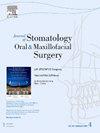从口腔内患者图像中检测口腔癌病变的深度学习方法:初步回顾性研究。
IF 1.8
3区 医学
Q2 DENTISTRY, ORAL SURGERY & MEDICINE
Journal of Stomatology Oral and Maxillofacial Surgery
Pub Date : 2024-10-01
DOI:10.1016/j.jormas.2024.101975
引用次数: 0
摘要
导言:口腔中的口腔鳞状细胞癌(OSCC)是牙科医生可以诊断甚至治愈的一类疾病。本研究评估了为检测口腔内回顾性患者图像中的口腔癌病灶而开发的计算机诊断软件的性能:使用 CranioCatch 标记程序(CranioCatch,Eskişehir,土耳其)和多边形标记方法对口腔癌病灶进行标记,这些病灶来自本诊所经切口活检组织病理学诊断为口腔癌的总共 65 张匿名口腔内回顾性患者图像。所有图像均由经验丰富的专家重新检查和验证。该数据集分为训练集(53 张)、验证集(6 张)和测试集(6 张)。人工智能模型采用 YOLOv5 架构开发,这是一种深度学习方法。用混淆矩阵评估了模型的成功率:在评估预留用于测试而未用于教学的图像的成功率时,发现使用 YOLOv5 架构获得的人工智能模型的 F1、灵敏度和精确度结果分别为 0.667、0.667 和 0.667:我们的研究表明,OCSCC 病变具有可辨别的视觉外观,可以通过深度学习算法进行识别。人工智能在口腔癌病变的预诊中大有可为。随着更多图像形成数据集的训练模型,成功率会越来越高。本文章由计算机程序翻译,如有差异,请以英文原文为准。
A deep learning approach to detection of oral cancer lesions from intra oral patient images: A preliminary retrospective study
Introduction
Oral squamous cell carcinomas (OSCC) seen in the oral cavity are a category of diseases for which dentists may diagnose and even cure. This study evaluated the performance of diagnostic computer software developed to detect oral cancer lesions in intra-oral retrospective patient images.
Materials and methods
Oral cancer lesions were labeled with CranioCatch labeling program (CranioCatch, Eskişehir, Turkey) and polygonal type labeling method on a total of 65 anonymous retrospective intraoral patient images of oral mucosa that were diagnosed with oral cancer histopathologically by incisional biopsy from individuals in our clinic. All images have been rechecked and verified by experienced experts. This data set was divided into training (n = 53), validation (n = 6) and test (n = 6) sets. Artificial intelligence model was developed using YOLOv5 architecture, which is a deep learning approach. Model success was evaluated with confusion matrix.
Results
When the success rate in estimating the images reserved for the test not used in education was evaluated, the F1, sensitivity and precision results of the artificial intelligence model obtained using the YOLOv5 architecture were found to be 0.667, 0.667 and 0.667, respectively.
Conclusions
Our study reveals that OCSCC lesions carry discriminative visual appearances, which can be identified by deep learning algorithm. Artificial intelligence shows promise in the prediagnosis of oral cancer lesions. The success rates will increase in the training models of the data set that will be formed with more images.
求助全文
通过发布文献求助,成功后即可免费获取论文全文。
去求助
来源期刊

Journal of Stomatology Oral and Maxillofacial Surgery
Surgery, Dentistry, Oral Surgery and Medicine, Otorhinolaryngology and Facial Plastic Surgery
CiteScore
2.30
自引率
9.10%
发文量
0
审稿时长
23 days
 求助内容:
求助内容: 应助结果提醒方式:
应助结果提醒方式:


